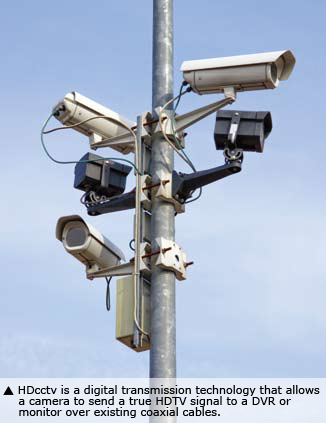Todd Rockoff, Executive Director of the HDcctv Alliance, discusses storage and
bandwidth considerations in HD video.
Todd Rockoff, Executive Director of the HDcctv Alliance, discusses storage and bandwidth considerations in HD video.
HD video is among the fastest growing segments in the surveillance equipment market, yielding up to six times more pixels per second than analog cameras. If not managed appropriately, the resulting volume of image data can overwhelm a video surveillance system.
Today, the high-resolution video market is served primarily by megapixel cameras transmitting captured video via streams of IP packets, with each containing a portion of compressed video. The video is compressed prior to transmission to meet network bandwidth constraints. The compression of video for transmission also addresses the potential storage problem at the source, by significantly reducing the amount of video data available for storage.
Unfortunately, that reduction comes at the cost of reduced image quality, which can impact live-view applications. For this reason, IP-based technology may not be ideal for delivering a high-resolution video signal from a camera directly to a manned control room.
HDcctv technology has emerged as an alternative to IP-based networking for camera connections in high-resolution video applications and offers many advantages. HDcctv is more convenient to implement for existing CCTV installations, less complicated to operate and intrinsically less costly.
Storage Challenge?
 Because HDcctv cameras deliver so much more data than other cameras, there is a concern that HDcctv presents a particularly difficult system design challenge with respect to storage. While HDcctv cameras deliver higher-quality evidence than the alternatives, HDcctv DVRs are not obligated to record maximum resolution, real-time, least-compressed video. HDcctv DVRs capture best-quality video in bursts as required, thereby being capable of collecting evidence of highest value without a corresponding requirement for expensive storage subsystems. Analog and IP-based systems do not offer the option to save the highest quality video at the DVR or NVR because the transmitted images are captured at relatively low resolution or they are compressed for transmission.
Because HDcctv cameras deliver so much more data than other cameras, there is a concern that HDcctv presents a particularly difficult system design challenge with respect to storage. While HDcctv cameras deliver higher-quality evidence than the alternatives, HDcctv DVRs are not obligated to record maximum resolution, real-time, least-compressed video. HDcctv DVRs capture best-quality video in bursts as required, thereby being capable of collecting evidence of highest value without a corresponding requirement for expensive storage subsystems. Analog and IP-based systems do not offer the option to save the highest quality video at the DVR or NVR because the transmitted images are captured at relatively low resolution or they are compressed for transmission.
Most operators and installers know how to optimize the price/performance trade-offs of storage in conventional DVRs. This article highlights that the management of storage in an HDcctv DVR is directly analogous to the management of storage in a conventional DVR.
The HDcctv Alternative
IP networks are designed to tolerate dropped packets. Dropped packets lead to dropped frames in transmitted video, which are perceived as reduced video quality. Also, IP networks tend to impose transmission bandwidth restrictions. Network cameras are challenged to deliver clear images because fine details tend to be eliminated by the compression, which must be applied to squeeze the video into the available IP network bandwidth.
End users are increasingly demanding high-resolution video to capture critical details. To meet this growing requirement, the surveillance equipment industry has offered megapixel cameras. Taken together, the fundamental barriers to adoption of IP-based systems motivate a search for an alternative to high-resolution video that can be readily adopted by the installed base of CCTV customers.
HDcctv is a digital transmission technology that allows a camera to send a true HDTV signal to a DVR or monitor over existing coaxial cables. HDcctv delivers uncompressed video, behaving just like analog CCTV. An installer needs only to plug the camera into an HDcctvcompliant DVR and begin recording.
HDcctv is based on the HD-SDI technology used in TV studios around the world to carry uncompressed HDTV signals over coaxial cables. It is enabled by chips developed for the broadcast television industry and was developed under a technology license between the HDcctv Alliance and the global standards body that created HD-SDI. HDcctv differs from HD-SDI in that it provides features for CCTV and is tuned specifically for the physical characteristics of the types of coaxial cable most commonly found in CCTV installations.
The HDcctv standard is managed by the HDcctv Alliance, and future versions will include additional features that are important for video surveillance: bidirectional data over coaxial, bidirectional audio, power up the cable, and definitions of additional physical layers, including Category cable and fiber optics. The HDcctv standard will continue to track broadcast television standards, including resolutions projected to approach 20 million pixels per frame of video, and apply them to the specific requirements of video surveillance.
Storage Bottleneck: Fact or Fiction?
Uncompressed video digitally delivered to a DVR is wonderful for live monitoring, performing analytics and providing the best quality of evidence. While each HDcctv camera does present up to six times more pixels per second than an NTSC/PAL camera, the sheer amount of video data does not present an insurmountable storage challenge.
Conventional DVR storage management techniques, proven to be able to handle large amounts of data, scale directly to the data rates of HDcctv. Does an HDcctv DVR require six times the storage space of an analog DVR? Not necessarily. High-resolution video surveillance equipment generally attracts a price premium over D1-resolution equipment to allow for such a storage expansion.
 Five factors are traded off by an installer or operator when managing storage in a CCTV system. They are: resolution of stored images; frame rate at which images are stored; quality of stored images (also called compression bit rate); duration of time for which video is kept before being over-written; and capacity of the storage system.
Five factors are traded off by an installer or operator when managing storage in a CCTV system. They are: resolution of stored images; frame rate at which images are stored; quality of stored images (also called compression bit rate); duration of time for which video is kept before being over-written; and capacity of the storage system.
The last factor, storage capacity, is a cost. The first four factors define a system's surveillance value envelope. In a conventional DVR, these four factors are varied over time, either by schedule or by alarm conditions. An HDcctv DVR works in much the same way as a conventional DVR from this point of view. In an HDcctv DVR, it is also possible to limit how much storage is used when the system is commissioned.
Note that an IP-based system might generally be expected to require less storage than a corresponding HDcctv system. This advantage is, however, illusory. The raw bandwidth required to transmit a 720p60 or 1,080p30 HDTV signal is 1.5 gigabits per second, which is more than even a dedicated Gigabit Ethernet could sustain. In order to squeeze the video into the limited network bandwidth available, network cameras usually compress video file sizes by up to a factor of 1,000. This heavy compression does lead to a relatively small file size. Unfortunately, the heavy compression intrinsically detracts from image quality, blurring, for example, the very high-resolution details for which the customer paid a premium.
This compression takes place for only one reason: to accommodate the restrictions of network bandwidth. Yet network bandwidth is not among the five fundamental factors listed above that are traded off to manage storage in a CCTV system. Network cameras introduce network bandwidth as an additional consideration which is not intrinsically related to physical security but which nonetheless increases the complexity of managing storage in a surveillance system.
Equipment Interoperability
The first version of the HDcctv specification was ratified by the HDcctv Alliance in January 2010. HDcctv v1.0 is, for the most part, a subset of the HD-SDI standard. The gating item for shipment of certified HDcctv equipment is ratification of v1.1, the compliance certification standard. v1.1 was ratified in early June 2010. It includes the test equipment used, methods followed, and measurements taken in order for a product to display the HDcctv logo as proof of interoperability.
Certified HDcctv equipment should begin shipping by September 2010. Given the natural evolution of the surveillance equipment buying cycle, this is an appropriate time for integrators, installers and end customers to evaluate the relative merits of HDcctv technology.
HDcctv v1.2 will define compliance requirements for products achieving true 720p or 1,080p resolution. A draft of the v1.2 HDcctv specification is expected by August 2010. HDcctv v2.0 and subsequent versions will include many valuable surveillance features. A draft of the v2.0 HDcctv specification is expected by October 2010.